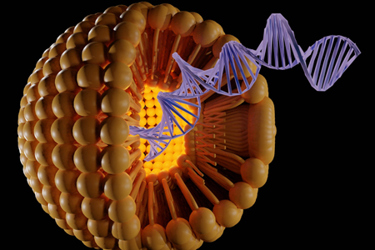Liposome Drug Delivery: Global Trends & Market Forecast
By Shalini Nagar, Research Nester

Liposomes are small vesicles composed of lipid bilayers. They have a spherical shape and a watery center. Liposomes are frequently employed as carriers for delivering drugs because of their structure and characteristics. Liposomes consist of phospholipids, which are amphiphilic molecules that have both water loving and water repelling properties. In an aqueous environment, these molecules arrange themselves into bilayers with the water loving heads on the outside and the water repelling tails on the inside.
Liposomes possess the ability to encapsulate drugs of both hydrophilic and hydrophobic nature. They achieve this by storing drugs in their aqueous core and hydrophobic drugs in their lipid bilayers. This unique characteristic allows liposomes to efficiently transport drugs to specific target sites in the body. Moreover, when the lipid bilayers of liposomes merge with cell membranes, they facilitate the controlled release of the encapsulated drug into targeted cells. Additionally, liposomes offer benefits by safeguarding drugs against degradation and enhancing their solubility and stability.
Liposomes can enhance the solubility of hydrophobic drugs to mitigate their toxicity. Moreover, liposomes can be tailored to target tissues or cells, enabling precise drug delivery. When the liposomes reach the intended site, they release the medications either through diffusion or in response to specific triggers.
Liposome drug delivery offers several advantages over other methods, including:
- Improved drug efficacy: Liposomes can improve the solubility, stability, and bioavailability of medications, which ultimately results in enhanced treatment results.
- Reduced side effects: Targeted drug delivery minimizes the exposure of healthy tissues to the drug, reducing the risk of adverse effects.
- Extended drug release: Liposomes have the capability to be formulated in a way that enables them to gradually release the medication, leading to lasting therapeutic benefits and minimizing the need for frequent dosing.
- Versatility: Liposomes can encapsulate a wide range of drugs, including hydrophilic and hydrophobic compounds, making them suitable for various therapeutic applications.
Mechanism Of Liposome Drug Delivery
The process of delivering drugs using liposomes involves several steps. Initially, the drug of interest is loaded into the liposomes using methods like passive or active drug loading techniques, such as remote loading or pH gradient loading.
Once the drug is loaded, the liposomes can be administered to patients through routes such as intravenous injection, oral ingestion, or topical application. The choice of administration route depends on the intended target site and desired therapeutic effects.
After administration, the liposomes circulate in the bloodstream. They can accumulate at the target site through mechanisms like passive targeting or active targeting. Passive targeting takes advantage of the enhanced permeability and retention effect (EPR effect), which allows liposomes to accumulate in tumor tissues due to their blood vessels and impaired lymphatic drainage. On the other hand, active targeting involves attaching targeting ligands to the surface of liposomes that can recognize and bind to specific receptors on target cells.
Once at the target site, liposomes release the enclosed drug using mechanisms such as diffusion, membrane fusion, or triggered release. The release of drugs can be controlled to achieve drug release or triggered drug release depending on specific therapeutic requirements.
Applications For Liposome Drug Delivery
Fungal Diseases: Liposomes have become an effective method of delivering medication to combat fungal infections. Their special characteristics allow them to deliver drugs directly to the affected areas, enhancing the effectiveness of treatment while minimizing any potential side effects. For instance, AmBisome is a drug delivery system that utilizes a single bilayer liposome. The key ingredient in AmBisome, known as amphotericin B for injection, effectively functions by attaching itself to the ergosterol component found in the cell membrane of vulnerable fungi.
Pain Management: Liposomes offer an effective solution for delivering pain-relieving medications to the affected areas, resulting in targeted and long-lasting relief. Encapsulating pain medications within liposomes can effectively minimize the side effects and systemic toxicity associated with these drugs. Liposomal bupivacaine has been approved by the FDA for use in a single dose to relieve postoperative pain in patients who have undergone hemorrhoidectomy or bunionectomy. At present, pain relief is achieved by injecting bupivacaine hydrochloride, an anesthetic, around the knee during surgery, which effectively alleviates pain for a period of 12 to 24 hours.
Cancer Therapy: Cancer treatment greatly benefits from the use of liposome drug delivery. Liposomes, which are nanoparticles made of liquid-lipids, can encapsulate and deliver anticancer medications directly to tumor cells. The use of liposomes in cancer therapy provides advantages. First, they enhance the solubility and stability of anticancer drugs, resulting in improved drug delivery and fewer side effects. Moreover, liposomes assist in boosting drug accumulation within tumor tissues, thereby increasing the effectiveness of treatment. Several liposomal delivery methods have been approved for treating cancer. Liposomes used in cancer treatment are usually 100 nm in size. This specific size is preferred because it allows the drug carriers to move out of the bloodstream and into the tumor through the blood vessels that support it. Doxorubicin, an anthracycline, is a commonly used drug for treating many types of cancer. It works by attaching itself to the DNA of cancer cells, which inhibits their ability to create genetic material. Additionally, it disrupts the activity of topoisomerase II, which causes mutations and abnormalities that can ultimately result in cell death.
Viral Vaccines: Liposomes can enhance the effectiveness of viral vaccines. They do this by enclosing the antigens and safeguarding them against degradation, resulting in a robust immune response. Liposomal vaccines are commercially available now for influenza hepatitis A viruses, malaria, and Varicella zoster virus. These vaccines are known as Inflexal for influenza, Epaxal for hepatitis A, Mosquirix for malaria, and Shingrix for Varicella zoster virus. Furthermore, liposomes can shield vaccines from degradation, prolonging their shelf life and easing the conditions under which they are stored and transported.
Photodynamic Therapy: Photodynamic therapy (PDT) is a medical treatment that uses light sensitive medications and a particular type of light to eliminate cancer cells and other specific conditions. Liposomes have emerged as a method of delivering photosensitizing drugs to targeted tissues in photodynamic therapy. By loading photosensitizers into liposomes, they can be precisely delivered to tumor tissues and accumulate in the desired area. Once the liposomes have accumulated in the targeted tissue, a specific wavelength of light is applied to activate the photosensitizers, generating reactive oxygen species (ROS). These ROS created during therapy can cause damage to cancer cells, ultimately leading to their elimination.
Liposome Drug Delivery Technologies
Stealth Technology: Stealth liposome technology plays a vital role in the delivery of liposome drugs. It allows for targeting of drug delivery and prolongs the time that liposomes remain in circulation within the body. This technology involves modifying liposomes with polymers like polyethylene glycol (PEG), which forms a protective layer around them. This layer helps shield the liposomes from being recognized and cleared by the system, enabling them to stay in the bloodstream for an extended period of time.
Non-PEGylated Technology: Non-PEGylated liposome technology represents an advancement in the field of liposome drug delivery. It provides stability and decreased toxicity when compared to PEGylated liposomes. A recent research study discovered that liposomes loaded with DOX (doxorubicin) were effectively created using PEGylated and non-PEGylated formulations. These liposomes exhibited average sizes, size distributions, and zeta potentials. Additionally, they demonstrated drug entrapment efficiencies of over 90%. Also, their effectiveness against tumors revealed that liposomal DOX was more successful in controlling tumor growth.
DepoFoam Liposome Technology: DepoFoam liposome technology is a unique approach that enables the gradual release of medications for a prolonged duration. This technology proves beneficial for long-term drug administration. By providing extended release capabilities, DepoFoam liposome technology helps reduce the frequency of medication intake, enhancing convenience and adherence for patients.
DepoFoam technology utilizes particles called multivesicular liposomes (MVLs) that have a granular structure and appear as spheroids when viewed under a light microscope. These MVLs have a diameter of 10 12 μm. The architectural structure of MVLs resembles soap bubbles as they consist of numerous polyhedral compartments filled with water with each compartment separated by thin walls.
Market Overview
The liposome drug delivery (LDD) market is witnessing significant growth, with the potential to revolutionize drug delivery methods and enhance therapeutic outcomes.
According to Research Nester, it is projected that the LDD market will exceed $10 billion by the end of 2035, growing at a compound growth rate (CAGR) of 9% during the forecast period from 2023 to 2035. In 2022, the liposome drug delivery industry had an estimated worth of $5 billion. This growth can be attributed to factors such as increased investments in research and development activities, a rise in the prevalence of chronic diseases, and a growing demand for personalized medicine. Also, recent advancements in liposome manufacturing techniques and the development of new liposomal formulations have contributed significantly to expanding the market.
The liposome drug delivery market has potential for future growth. The demand for formulations is being driven by the growing emphasis on targeted therapies and personalized medicine and the necessity for enhanced drug delivery systems. Additionally, the increasing use of liposome-based drugs in areas such as oncology, infectious diseases, and other therapeutic fields is anticipated to contribute to market expansion.
Market Challenges
Challenge: One of the major obstacles in delivering drugs through liposomes is the limited ability to penetrate the poor blood-brain barrier. This limitation hampers the effectiveness of drugs that target the nervous system.
Innovative Solution: A groundbreaking approach to tackle this issue involves utilizing liposomal nanoparticles that have a targeted delivery mechanism. These nanoparticles can be precisely designed to attach to receptors on the blood-brain barrier, enabling enhanced drug penetration and effectiveness when targeting the nervous system.
Challenge: Another challenge faced in liposome drug delivery is the limited lifespan and instability of liposomes. This can result in their deterioration and reduced effectiveness as time goes by.
Innovative Solution: One effective approach to address this issue involves encapsulating liposomes within stable carriers, like polymers or other liposomes. This strategy aims to enhance the stability and longevity of liposomes, resulting in improved drug delivery that lasts for a longer duration and is more efficient.
Key Players In The Industry
The liposome drug delivery industry is composed of several key players who have made significant contributions to the field, including Spectrum Pharmaceuticals, Celsion, Ipsen Pharma, Pacira Pharmaceuticals, CordenPharma International, FUJIFILM Toyama Chemical, Takeda Pharmaceutical Company, and others. These companies specialize in creating and producing liposomal drug formulations, and their products have become popular due to their effectiveness and distinct benefits. They have made advancements in this field such as:
- Johnson & Johnson has a wealth of expertise in formulating and delivering drugs using liposomes. It is the creator of Doxil, the first liposomal drug approved by the FDA for treating cancer.
- Merrimack Pharmaceuticals is a producer of liposomal medications for a range of medical fields. Its notable creation, Onivyde, is a liposomal drug specifically designed to combat pancreatic cancer.
- Gilead Sciences created Veklury, a liposomal drug specifically designed for treating COVID-19.
- Teva Pharmaceutical Industries is a large-scale producer of liposomal medications. It has developed Liposomal Amphotericin B, a medication used for treating fungal infections.
- Evonik Healthcare introduced a version of its LIPEX liposome extruder for oncology treatment, vaccines, and other therapeutic applications in 2021.

Shalini Nagar is a content associate at Research Nester Pvt. Ltd.
